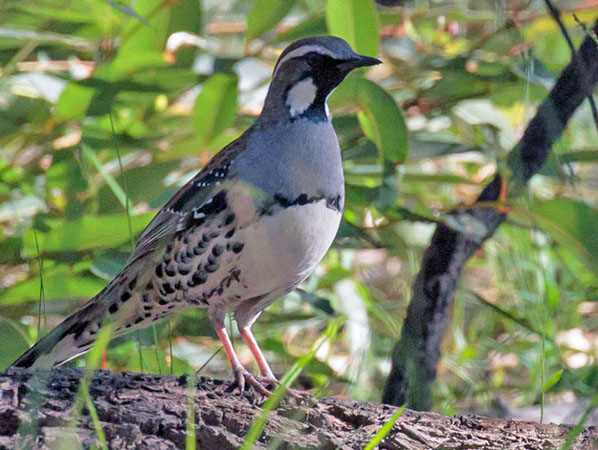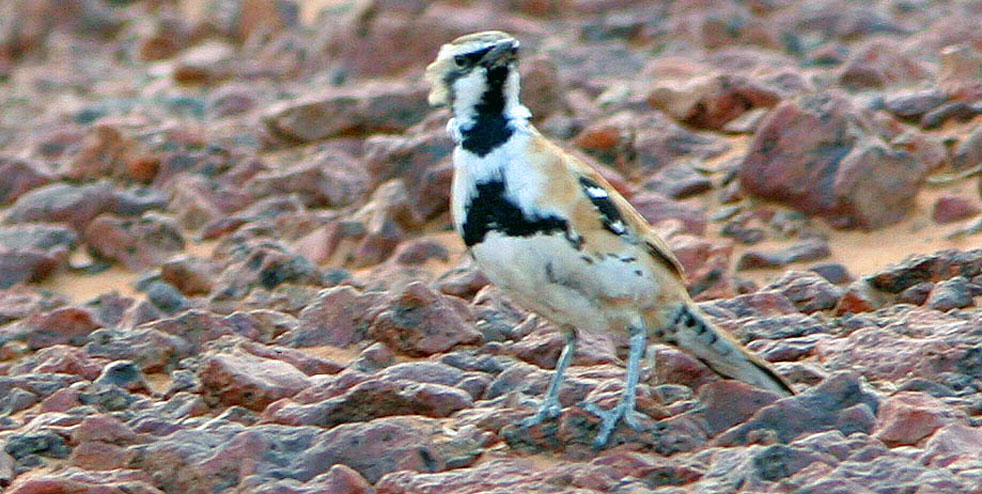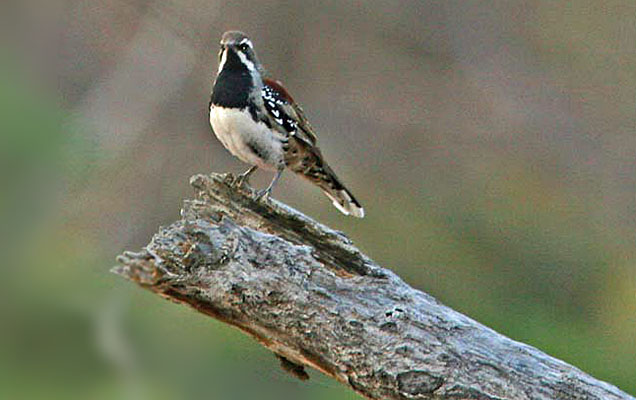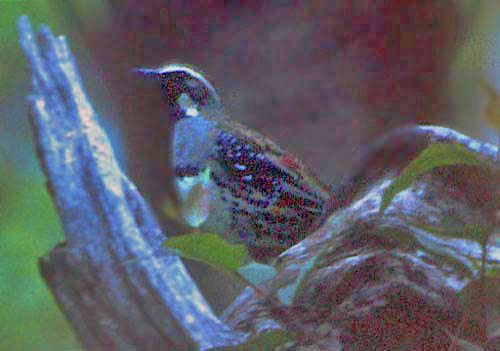
a web page by Don Roberson |
QUAIL-THRUSHES & JEWEL-BABBLERS Cinclosomatidae |
|
 The Cinclosomatidae is a small family of secretive, ground-dwelling birds of Australasia. Seven of 8 species of quail-thrush [genus Cinclosoma] inhabit Australia; the other resides in New Guinea. The four species of jewel-babbler [genus Ptilorrhoa] are New Guinea endemics. Quail-thrushes and jewel-babblers recall elongated thrushes but they arose in the great corvoid assemblage in the proto-Papuan archipelago. They are not remotely related to thrushes (Barker et al. 2004). Quail-thrushes are shy ground dwellers that move quietly in pairs or small parties. All are patterned in earth tones — various combinations of brown, black, gray, chestnut, cinnamon, and white — while jewel-babblers feature blue, white, and rusty plumages. Each of them is a spectacular bird, and their retiring behavior just adds to their allure. An example is Spotted Quail-thrush (left, a lovely shot by Murray Lord), a species of in wet eucalyptus forest in eastern Australia. This species has been declining with encroaching development. The Cinclosomatidae is a small family of secretive, ground-dwelling birds of Australasia. Seven of 8 species of quail-thrush [genus Cinclosoma] inhabit Australia; the other resides in New Guinea. The four species of jewel-babbler [genus Ptilorrhoa] are New Guinea endemics. Quail-thrushes and jewel-babblers recall elongated thrushes but they arose in the great corvoid assemblage in the proto-Papuan archipelago. They are not remotely related to thrushes (Barker et al. 2004). Quail-thrushes are shy ground dwellers that move quietly in pairs or small parties. All are patterned in earth tones — various combinations of brown, black, gray, chestnut, cinnamon, and white — while jewel-babblers feature blue, white, and rusty plumages. Each of them is a spectacular bird, and their retiring behavior just adds to their allure. An example is Spotted Quail-thrush (left, a lovely shot by Murray Lord), a species of in wet eucalyptus forest in eastern Australia. This species has been declining with encroaching development. |
|
| When the first version of this page was created in 2004, there were just five species of quail-thrush, and just four in Australia (e.g., Boles 2007). Now the number of endemic Australian quail-thrushes has nearly doubled, to 7 species. This is primarily because molecular evidence has found deep divergences in isolated populations across the arid interior of Australia (Toon et al. 2012, McElroy et al. 2020). One example was Nullarbor Quail-thrush Cinclosoma alisteri, a southwestern population split (Toon et al. 2012) from the more central Australian population of Cinnamon Quail-thrush (photo below), where it is a bird of arid, stony country and sandhills. |
 |
All quail-thrushes build cup-like nests, usually placed in scrapes on the ground. Inland species do not start breeding until the onset of desert rains (Simpson & Day 1996, Boles 2007). The New Guinea quail-thrush is Painted Quail-thrush C. ajax, and has been known by the old name of "Ajax Scrub-Robin," of all things. It has a drawn-out whistled call, like a jewel-babbler, but with two short introductory notes (Beehler et al. 1986). Like many things Papuan, rather little is known about it. The three jewel-babblers are drop dead gorgeous. They are resident in specific elevational zones in New Guinea. Blue Jewel-babbler Ptilorrhoa caerulescens is the lowland species and Dimorphic Jewel-babbler P. geislerorum the foothill bird in the northwest; both are dark royal-blue with contrasting white throat and breast. Chestnut-backed Jewel-babbler P. castanonota is the middle-elevation taxon throughout montane New Guinea; it is rich blue with white throat and chestnut crown and back. Spotted Jewel-babbler P. leucosticta is the cloud-forest species at upper elevations, with a brown (not chestnut) back and prominent white spots on black upperwing coverts. Each is shy, elusive, and much more often heard than seen. Some enticing photos of jewel-babblers are in Coates (1990) and Boles (2007). |
The taxonomic history of these unique and beautiful birds has been long and checkered. For a long time the Quail-thrushes were considered to be among the Orthonychidae (Logrunners) of Australia, and older works tend to lump them together, along with whipbirds, wedgebills, and jewel-babblers. Beehler et al. (1986) also included the two melampittas of New Guinea (Melampitta), and Blue-capped Ifrita Ifrita kowaldi, in this family. Some also included the Rail-babbler Eupetes macrocerus, occurring in lowland primary forests of peninsular Thailand, Malaysia, Sumatra, and Borneo, which had been traditionally considered a babbler (hence the name). Sibley & Ahlquist (1990), using DNA hybridization evidence for some of the taxa, separated the Quail-thrushes from the Logrunners but left all most of the remaining groups (whipbirds, wedgebills, jewel-babblers, Ifrita, and rail-babbler) with the Quail-thrushes in their subfamily Cinclosomatinae in a huge Corvidae family. [Melampittas were transferred to birds-of-paradise at that time.] Dickinson 2003) placed just the five recognized quail-thrushes in a modified Cinclosomatidae, and assigned the whipbirds, wedgebills, jewel-babblers and rail-babbler to a newly created Eupetidae. The Handbook of the Birds of the World series (Boles 2007) put all of those, plus quail-thrushes and melampittas, in a mixed soup they called Eupetidae. Today, after molecular evidence was published (e.g., Barker et al. 2004, Jønsson et al. 2001, Aggerbeck et al 2014), the elements of the gumbo have been scattered to the wind, and many are not very closely related. The whipbirds and wedgebills are actually somewhat closed related to quail-thrush, but now have their own family [Psophodidae], as do the rather distant Melampittas [Melampittidae]. Rail-babbler is now known to be an ancient lineage deserving of its own family [Eupetidae] in which it is the only member. Likewise, the New Guinea endemic Blue-capped Ifrita has its own monotypic family [Ifritidae]. When the dust settled, this left the quail-thrushes and jewel-babblers as the remaining members of the Cinclosomatidae. |
Photos: Murray Lord took the top photo of Spotted Quail-thrush Cinclosoma punctatum at Colo, New South Wales, Australia, on 5 June 2020; my own digitized slide of Spotted Quail-thrush, at the bottom of this page, was taken in Lamington NP, Queensland, Australia, on 7 Nov 1983. The male Chestnut Quail-thrush Cinclosoma castanotum was at Gluepot Reserve, South Australia, on 18 Nov 2009. The Cinnamon Quail-thrush Cinclosoma cinnamomeum was at Cowrie Station, along the Birdsville Track in northern South Australia, on 20 Nov 2009. All photos © Don Roberson, except that attributed © Murray Lord, and used with permission; all rights reserved. Bibliographic note: There is no "family book" per se, but an introduction to the birds in this family, among pieces of other families, along with good photos, are in Boles (2007). Nice photographs and information about Australian and New Guinea species are found, respectively, in Frith (1979) and Coates (1990). Literature cited:
|
 All quail-thrushes forage on the ground, eating a wide variety of insects, although some inland species also eat spinifex seeds. They walk deliberately with frequent and rather erratic changes of direction; they do not scratch but rather probe crevices encountered. They often squat when disturbed, and when pressed may run, using the vegetation for cover, rather than fly. They are often best located by voice, a high-pitched note that can be hard for some to hear (Simpson & Day 1996). Despite their primarily terrestrial ways, males may sit up on logs to check out the surroundings, as this Chestnut Quail-thrush is doing (right). Males have the striking black throat while females are gray-throated. If disturbed will usually flush, quail-like, on short whirring wings, showing prominent white tail tips as they depart (Morcombe 2000).
All quail-thrushes forage on the ground, eating a wide variety of insects, although some inland species also eat spinifex seeds. They walk deliberately with frequent and rather erratic changes of direction; they do not scratch but rather probe crevices encountered. They often squat when disturbed, and when pressed may run, using the vegetation for cover, rather than fly. They are often best located by voice, a high-pitched note that can be hard for some to hear (Simpson & Day 1996). Despite their primarily terrestrial ways, males may sit up on logs to check out the surroundings, as this Chestnut Quail-thrush is doing (right). Males have the striking black throat while females are gray-throated. If disturbed will usually flush, quail-like, on short whirring wings, showing prominent white tail tips as they depart (Morcombe 2000).
 My first member of this engaging family was Spotted Quail-thrush, which I even managed to photograph with a slide-film camera back in 1983 (right). In the almost 40 years since, my encounters with additional family members have been few and far between.
My first member of this engaging family was Spotted Quail-thrush, which I even managed to photograph with a slide-film camera back in 1983 (right). In the almost 40 years since, my encounters with additional family members have been few and far between.